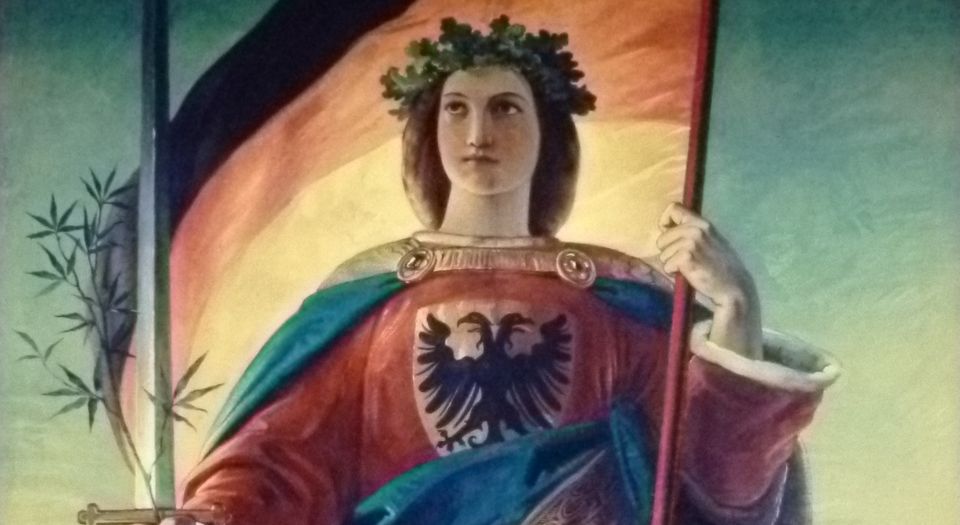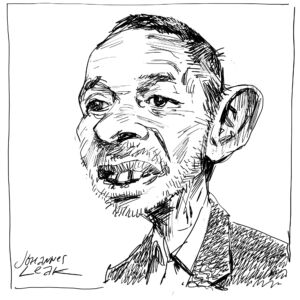
Long-read
The hidden history of identity politics
How a revolt against the Enlightenment came to dominate public life.
Want to read spiked ad-free? Become a spiked supporter.
Identity politics is the dominant force in Western public life today. Yet too many draw the conclusion that the 21st-century identitarian is simply the latest version of those activists who demanded women’s or black liberation in the 1960s. This is misleading because it ignores the extent to which the drivers and concerns of identity politics have changed over the decades.
Indeed, since the politics of identity first emerged in the late 18th century, it has undergone significant transformations. It has been embraced by conservative movements, and celebrated by radical ones; it has focused on large-scale identities such as nations or peoples, and concentrated on particular individuals; and although it is identified today as a leftist force, it has often provided a political narrative for those on the right, be they traditionalists or nationalists.
So, if one is to grasp what is unique about contemporary identity politics, it is essential to explore its history. This can be divided up into four phases.
Phase one: The revolt against Enlightenment universalism
It was in the late 18th century that the seeds of what would grow into identity politics were first sown. At this point, the politicisation of identity drew its energy from the conservative reaction to the Enlightenment, and particularly its championing of universalism. This counter-Enlightenment condemned the idea of human universality and claimed that the only identity that mattered was that of particular peoples and groups. The particularist hostility to the universalist outlook of the Enlightenment was one of the most distinctive features of the 19th-century right-wing political imagination.
The conservative Romantic movement in Germany emphasised the importance of cultural differences, and claimed that identities founded upon it were more authentic than an abstract attachment to universalism. Such sentiments were, in part, a response to the growing influence of the rationalistic and universalistic ideals of French Enlightenment thought on European societies. So the German Romantics favourably contrasted authentic Kultur to the abstract spirit of French Enlightenment universalism. German philosopher Johann Gottfried Herder (1744–1803) forcefully captured the particularist spirit of the new Romantic worship of cultural identity. He claimed that it was culture that defined each people – the Volk – endowing them with their own distinct identity and spirit.
Animosity towards universalistic values and human solidarity was not confined to Germany. Similar sentiments were expressed by anti-Enlightenment identitarians in France. Joseph de Maistre, the French reactionary political philosopher, condemned the ideals associated with the rights of man as abstract nonsense. He asserted that there is ‘no such thing as man’. ‘I have seen Frenchmen, Italians and Russians’, he continued, but ‘as for man, I have never come across him anywhere’.
During the 19th century, the Romantic focus on the particular elevated differences of identity and celebrated the characteristics associated with the allegedly unique spirit of different peoples. Gradually, this notion of a distinct cultural spirit informed the narrative of nationalism, and the idea that each nation possessed unique characteristics. As the 19th-century French philosopher Ernest Renan put it, ‘the nation is a soul, a spiritual principle’.
The effect of the counter-Enlightenment advocacy of cultural heterogeneity and difference resulted in a form of epistemological separatism. This claim that different cultures had different ways of knowing effectively fossilised national identities. In doing so, it served as the cultural antecedent to the racial typologies that influenced Western thought in the 19th and early 20th centuries.
All this was anathema to the spirit of the Enlightenment. The Enlightenment had always been opposed to the traditional idea that who you are is defined by your birth, biology and your place in the natural order. Enlightenment thinkers argued that people made themselves through making history. That is how the Enlightenment was able to develop a form of consciousness that transcended the specific experience of individuals and individual groups. Today, when the striving for universalism is treated with cynicism, it is easy to forget that basic principles of equality and rights were embedded in the universalistic outlook.
During the interwar era, the counter-Enlightenment focus on national identity took an extreme form with the Nazis. This meant that anti-universalist particularist politics became associated with racism and, ultimately, the Holocaust. Little wonder that after the Second World War, right-wing identity politics was forced into retreat and its advocates had to try to cultivate a more moderate nationalist image.
Phase two: The left and the new social movements
In the wake of the Second World War, nationalist identity politics became marginalised. It would take another two decades for identity politics to revive. But this time, it was the left, rather than the right, that promoted group-related identity politics.
Despite its formal adherence to universal values, the left had always struggled genuinely to commit to them. Its record of support for anti-colonial movements, women’s equality or anti-racist struggles was patchy at best. Consequently, the liberation movements of the 1960s were forced to adopt their own strategies for realising their objectives. In the United States, sections of the civil-rights movement came to the conclusion that the politicisation of black identity was the way forward. Other groups and minorities embraced a similar approach towards gaining new rights. Hence movements for women’s and gay liberation focused on the specificity of female and gay experience to achieve the rights and freedoms they were denied.
These new social movements had a profound influence on the left itself, which had long been struggling to give meaning to wider forms of solidarity. And, gradually, the left’s focus shifted from class to identity.
For the New Left of the 1960s and 1970s, support for Third World liberation movements served as a unique source of radical identity. This was because in many Western societies, the very absence of any radical impulses in the domestic sphere disposed the New Left to search for causes abroad. In France, for example, the left identified with the Chinese Cultural Revolution rather than any domestic social force.
This Third Worldism coincided with the countercultural hostility to the dominant worldview of Western societies. Yet it was a hostility to the old order that never acquired a systematic political existence to the point where it could generate its own ideology or pose a serious alternative to the status quo. Indeed, the cultural conflicts over lifestyles and values that erupted in the 1960s and gained momentum in the 1970s did not turn into the interwar anti-parliamentary movements that some feared. Instead, the personal-is-political logic of the counterculture led it towards the embrace of identity politics, which meant a move ‘away from mass constituencies to single-issue campaigns’ (1).
Although expressed through a radical rhetoric of liberation and empowerment, the shift towards identity politics was conservative in impulse. It was a sensibility that celebrated the particular and which regarded the aspiration for universal values with suspicion. Hence the politics of identity focused on the consciousness of the self and on how the self was perceived. Identity politics was, and continues to be, the politics of ‘it’s all about me’.
Even when self-identity was expressed in group form, it was driven by the imperative of winning the recognition of others (2). As the historian Tony Judt noted, the doctrines that were developed to express the politics of identity were directed towards psychology and were often indifferent to the ‘traditional projects of social revolution’. Indeed, ‘they sought to undermine the very concept of the human subject that had once underlain them’ (3).
The emergence of different identity-based groups during the 1970s mirrored the lowering of expectations on the part of the left. This new sensibility was most strikingly expressed by the so-called ‘cultural turn’ of the left. The focus on the politics of culture, on image and representation, distracted the left from its traditional interest in social solidarity. And the most significant feature of the cultural turn was its sacralisation of identity. The ideals of difference and diversity had displaced those of human solidarity.
Phase three: The convergence of identity with victimhood
One of the most momentous developments in the history of identity politics was its convergence during the 1970s with the emerging politics of victimhood. This was not accidental. Both trends expressed the crisis of confidence of the left.
During the 1960s and 1970s, liberal and radical politics underwent a major transformation. Radicalism became exhausted and less and less invested in the project of social transformation. During this period, many of the left’s traditional allies came to be characterised as victims of the system. A similar pattern was in evident in the women’s movement. In the late 1960s and early 1970s, feminists argued vehemently against the representation of women as victims. By the late 1970s, however, this perspective had been fundamentally revised. Campaigns now stressed the woman as victim – battered, violated and raped. The left, too, regarded suffering as an important resource for mobilising a constituency behind its causes.
During the 1970s the meaning of victimisation was radically revised. Initially, the victim tended to be portrayed as the victim of a specific experience — for example, a victim of crime. However, during the 1970s, the meaning of victimisation expanded to encompass the experiences of a variety of different groups. This new approach also sought to transform the meaning of victimisation: it was no longer an exceptional form of harm suffered by an individual; it was also a condition integral to an unjust society. Through the redefinition and expansion of the victim experience, different groups claimed that being victims of society was a fundamental feature of their identity.
The redefinition of victim identity was self-consciously promoted by a new cohort of activists, who regarded their campaigns as a new form of radical politics. A comparison of the first edition of William Ryan’s classic Blaming The Victim, published in 1971, with his 1976 edition is telling. The main thesis of Blaming The Victim was that in the US, victims of inequality – black people, for example – were unfairly blamed for the problems facing society. Ryan offered a populist anti-capitalist thesis, which indicted not the criminal, but the system for its victimisation of people. By the time Ryan wrote the introduction to his 1976 thesis, his image of the victim had become far more expansive than it had been in 1970. He remarked:
‘Since 1970, I have also enlarged my vision of who the “victims” in American society really are. I had been focusing on the plight of the poor and of blacks. In fact, everyone who depends for the sustenance of himself and his family on salary and wages, and who does not have a separate source of income through some substantial ownership of wealth, is a potential victim in America.’ (4)
The thesis that virtually everyone outside the ruling elite was a potential victim suggested that, far from being an exceptional experience, victimisation was part of the existential reality of American culture.
A pervasive sense of victimisation was probably the most distinct cultural legacy of this era. The authority of the victim was ascendant. Sections of both the left and the right endorsed the legitimacy of the victim’s authoritative status. This meant that victimhood became an important cultural resource for identity construction. At times it seemed that everyone wanted to embrace the victim label. Competitive victimhood quickly led to attempts to create a hierarchy of victims. According to a study by an American sociologist, the different movements joined in an informal way to ‘generate a common mood of victimisation, moral indignation, and a self-righteous hostility against the common enemy – the white male’ (5). Not that the white male was excluded from the ambit of victimhood for long. In the 1980s, a new men’s movement emerged insisting that men, too, were an unrecognised and marginalised group of victims.
The range of hitherto unexceptional experiences reclassified as victimising expanded throughout the 1980s and 1990s. For example, groups of circumcised men in Britain and the US claimed that they had been mutilated and psychologically damaged by what is one of the earliest operations recorded in history. The National Organization to Halt the Abuse and Routine Mutilation of Males (NOHARMM) claimed to speak on behalf of the ‘victims of circumcision’. ‘We are all adult men who believe that we have been harmed by circumcision carried out in childhood by doctors in Britain’, wrote a group of 20 men in a letter published in the British Medical Journal in 1996 (6). Their claim to victim status was based not so much on the physical but the alleged psychological harm of this otherwise routine operation. They seek to restore the foreskin because it is ‘therapeutic for men’. As two campaigners argued, ‘[restoration of the foreskin] improves body image, improves self-esteem, dispels feelings of victimisation, and empowers men to make choices about their own sexuality’ (7).
Phase four: The therapeutic ethos of identity politics
A key innovation in the construction of the victim in the 1970s was its representation of the victim as blameless. Indeed, one of the most widely used rhetorical devices of victim advocates was to dismiss any querying of an individual’s or a group’s claims as ‘blaming the victim’. Radical criminologists argued that unfair blame was attached not only to victims of crime but to all disadvantaged people. Ryan’s Blaming the Victim (1971) played an important role in delegitimising any questions raised about the claims of victim advocates.
The notion of the ‘blameless victim’ endowed self-proclaimed victims with moral authority. Consequently, over time, the victim identity came to be seen almost as sacred. As one study observed, ‘victim’ was increasingly used as a moral concept. ‘Being a victim implies a certain degree of innocence or blamelessness, so that the victim is not held responsible for his or her fate’, wrote Frank Weed (8).
Advocates of victim culture did not only argue that their constituency was blameless, but also that victims had to be believed. The presumption of victims’ credibility picked up momentum in relation to the victimisation of children. The exhortation to ‘believe the child’ was swiftly followed by the preposterous claim that ‘children do not lie’. In recent decades, the mantra of ‘believe the victim’ has become institutionalised to the point where those accused of a misdeed are presumed to be guilty until they can prove their innocence. That is why those raising awareness, and expanding the definition, of sexual harassment, bullying and microaggression contend that what matters is whether or not the ‘victims’ believe they were victimised rather than the actual intentions of those whom they are accusing. This speaks to an important psychological turn in identity politics.
Victimhood provided identity politics with moral authority. Political movements that were hitherto committed to liberation and social transformation began to perceive and present themselves as victim groups. They deployed the exhortation ‘believe the victim’ as an argument for respect and validation. The argument that victims were blameless was reframed as a claim that a particular identity group’s version of reality could not be subjected to questioning or debate.
Outwardly, the latest version of identity politics – which is distinguished by a synthesis of victim consciousness and concern with therapeutic validation – appears to have little in common with its 19th-century predecessor. However, in one important respect it represents a continuation of the particularist outlook and epistemology of 19th-century identitarians. Both versions insist that only those who lived in and experienced the particular culture that underpins their identity can understand their reality. In this sense, identity provides a patent on who can have a say or a voice about matters pertaining to a particular culture.
Increasingly, advocates of identity politics assert that there are matters on which only women or gay people can speak. Cultural and identity-related boundaries have solidified and are now intensively policed. A ‘Keep Out’ sign often greets individuals who appear to question the monopoly that cultural entrepreneurs have over the understanding of their identity. Those who dare intrude into a designated cultural space are denounced as exploitative practitioners of ‘cultural appropriation’.
The dogma of believing the victim has been recycled as an argument for closing down discussion on any matter that identitarians find offensive. From their standpoint, any criticism of the causes promoted by identitarians is a cultural crime. The obligation to believe and not criticise individuals claiming victim identity is justified on therapeutic grounds. Criticism is said to constitute a form of psychological re-victimisation and therefore causes psychic wounding and mental harm. This therapeutically informed argument against the exercise of critical judgement and free speech regards criticism as an attack not just on views and opinions, but also on the person holding them. The result is censorious and illiberal. That is why in society, and especially on university campuses, it is often impossible to debate certain issues.
The end of solidarity
Since its therapeutic turn, identity politics has come to be less focused on political and social issues than its 1960s and 1970s versions were. In its current form, identity politics directs its energy towards gaining validation and respect. Old-school identity politics targeted what it saw as political, economic and social barriers, and directed its energy towards overcoming discrimination. Though it was devoted to the promotion of group identities, its principal goal was the achievement of equality. No doubt it possessed powerful separatist tendencies and a self-referential outlook on the world, but, unlike the politics of identity today, it did not project its objectives through the psychological and narcissistic language of ‘it’s all about me’. For example, 1970s feminism fought to overcome the social barriers that prevented women from achieving equality with men. Feminists who demanded to be treated on the same terms as men are very different to ones who emphasise and elevate the differences between genders, and who demand safe spaces and protection from microaggressions and badly worded compliments.
One of the least noticed but most significant features of the current phase of identity politics is its tendency towards fragmentation and individuation. There is a growing tendency towards the proliferation of identity groups and towards separatism. Moreover, everyone wants a piece of the action. Since the eruption of controversy over cultural appropriation, all kinds of new actors have piled in to stake a claim to a patent on their culture. Groups that have stood on the sidelines of cultural politics have recently embraced the language and practices of identity politics. So Chinese university students have attempted to close down discussion on their government’s behaviour in Tibet on the grounds that they find it culturally insensitive and offensive; Muslim and Jewish students have demanded safe spaces; and some conservative students have demanded protection from verbal attacks on campuses. Indeed, with growing calls to protect ‘white identity’, identity politics has become a caricature of itself.
Some proponents of identity politics refer to one another as allies. However, the politics of culture has rarely allowed the forging of strong bonds between different groups, as today’s acrimonious dispute between feminists and trans activists shows. Human solidarity is one of the main casualties of identity politics. Once different groups retreat into their respective safe spaces, there will be little common ground left for those committed to the politics of solidarity and the ideal of universalism.
Frank Furedi is a sociologist and commentator. His latest book, Populism And The Culture Wars In Europe: The Conflict Of Values Between Hungary and the EU, is published by Routledge. (Buy this book from Amazon(UK).)
(1) Postwar: A History of Europe Since 1945, by Tony Judt , Random House, 2007, p486.
(2) On the politics of recognition, see Therapy Culture, by Frank Furedi, Routledge, 2004.
(3) Postwar: A History of Europe Since 1945, by Tony Judt , Random House, 2007, p479.
(4) Blaming The Victim, by W Ryan, Vintage Books, 1976, pxiii.
(5) ‘Multiculturalism, Political Correctness’, by M E Spencer, Sociological Forum, vol9, no4, p559.
(6) British Medical Journal, 10 February 1996, p377.
(7) ‘The Right to Our Bodies’, F Hodges and J Warner, MEN Magazine, November 1995.
(8) Certainty of Justice; Reform in the Crime Victim, FJ Weed, Aldine Transaction, 1995.
Who funds spiked? You do
We are funded by you. And in this era of cancel culture and advertiser boycotts, we rely on your donations more than ever. Seventy per cent of our revenue comes from our readers’ donations – the vast majority giving just £5 per month. If you make a regular donation – of £5 a month or £50 a year – you can become a and enjoy:
–Ad-free reading
–Exclusive events
–Access to our comments section
It’s the best way to keep spiked going – and growing. Thank you!







Comments
Want to join the conversation?
Only spiked supporters and patrons, who donate regularly to us, can comment on our articles.